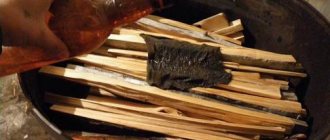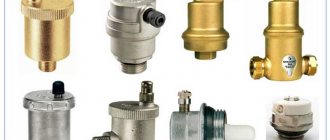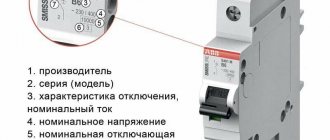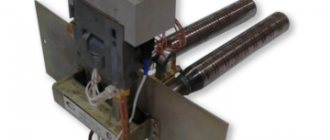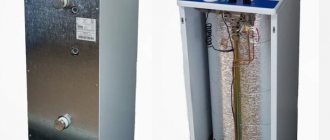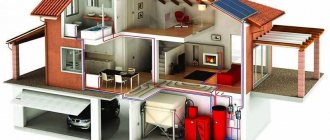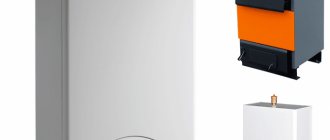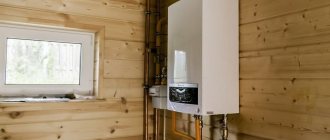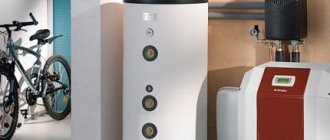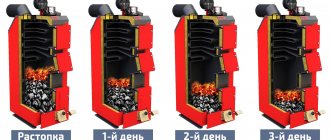Solid fuel boilers are a popular type of boiler equipment. They are widely used for autonomous heating in facilities where it is not possible to use models running on natural gas. Modern equipment of this class is capable of providing high-quality heating and at the same time is inexpensive, convenient and easy to operate. For maximum heating efficiency, it is important to have an idea of how to properly heat a solid fuel boiler.
The firing of a pyrolysis boiler has some peculiarities. A few wood chips and a sheet of paper are placed in the combustion (screw) hole, and firewood mixed with coal is placed in the loading door - most often it is located above the combustion door. A sheet of paper is set on fire, after which the fire is directed towards the fuel with a stream of air, starting the combustion process. For normal operation of the boiler, a constant supply and normal circulation of air is necessary.
Features of the operation of modern solid fuel boilers
Solid fuel boilers of the modern generation are equipped with a pressurization system and an automatic control unit. Electronics controls the temperature of the coolant using a sensor installed in the heat exchanger. Depending on the temperature conditions, the automation gives commands to turn on and off the blower, which supplies air to the combustion chamber and facilitates the effective removal of combustion products through the chimney. This regulates the intensity of the fuel combustion process depending on the temperature of the coolant.
Thus, the user takes the minimum necessary participation in the operation of the equipment. His concern about how to fire a TT boiler comes down to adding fuel at a certain frequency. After this, the boiler switches to intensive combustion mode. As the temperature rises, the combustion intensity weakens, and when the temperature reaches its maximum, the boiler goes into smoldering mode. After the coolant temperature drops below the set value, the boost is turned on again.
Timely loading of fuel into the TT boiler is the main task of the user, which cannot be automated. The number and frequency of fillings is determined based on the boiler power and the required temperature conditions. If you miss the start date, the boiler will only be able to operate in smoldering mode for a limited time, after which it stops.
It is of great importance how to heat a solid fuel boiler. Today the following types of fuel can be used for this purpose:
- firewood;
- coal;
- fuel briquettes;
- pellets.
To achieve maximum efficiency, you need to know how to effectively heat a solid fuel boiler with different types of fuel.
What to pay attention to
The operation of any heating device using coal, wood and other semi-finished fuel products is inextricably linked with the ventilation system. The performance characteristics of heating equipment and the technological parameters of the entire heating system in the house depend on the quality of ventilation and the condition of the chimney.
The hood must operate in accordance with established fire safety standards.
Important! An incorrectly made hood will create a risk of harmful combustion products entering living spaces. Insufficient traction will reduce the power of the device. Regular cleaning of the chimney will prevent soot from igniting, which can cause fire in house structures and create a fire hazard.
A properly made chimney and cleaning of the heating device will ensure long-term operation of the solid fuel boiler at optimal operating conditions. Frequently changing one type of fuel to another can cause unstable operation of the heating unit, failures in the hot water supply system and heat supply. Each unit should have one main fuel, while other types can be used for a short time, as needed.
Which fuel to choose
When deciding what is the best way to heat a solid fuel boiler, it is necessary to take into account the recommendations of the equipment manufacturer. Certain boiler models can be designed for specific fuels. However, many modern units are capable of operating on all of the listed types of fuel.
When choosing how to heat a long-burning solid fuel boiler conveniently and profitably, you need to take into account the burn rate of the fuel, which can vary greatly for different types. The frequency of necessary bookmarks and the ease of use of the unit depend on this.
Dry firewood is the fuel that burns out the fastest. Therefore, today fuel briquettes, which are made from dry sawdust, are often used for TT boilers. Such briquettes, which are also called “Eurowood”, burn out 1.5-2 times slower than ordinary dry firewood. Peat fuel briquettes are also produced. However, they are characterized by high ash content, and therefore peat briquettes are used mainly for water-heating boilers with grate fireboxes. Coal burns the slowest. Some coal boilers, using high-quality anthracite and additionally equipped with a heat accumulator, are able to operate on one load for up to two days even in severe frost.
Pellets burn almost as long as coal, and at the same time provide a high level of efficiency. However, it is also the most expensive type of solid fuel for modern boilers. The main advantage of pellets is that they allow you to automate the operation of the boiler as much as possible, bringing it closer in convenience to the level of a gas unit. However, they cannot be used in a conventional TT boiler - it must be equipped with a special burner and a combustion door of a special design.
Coal
Among various types of solid fuel, coal has the greatest heat transfer, which makes it one of the most efficient energy carriers in heating boilers. The amount of heat released during the combustion of coal is twice as high as that for wood and is about 7.5 kWh/kg.
Thus, to maintain a certain temperature of the coolant in the circuit, coal will require significantly less than other types of solid fuel.
The most efficient in terms of heat production is anthracite. It contains a minimum of moisture and impurities. However, it is very expensive and burns quickly, giving a very high temperature, which is simply not needed in heating boilers.
The advantages of coal are due to its physical and chemical properties:
- High calorific value. With proper boiler design, a bucket of coal may well last for a day. The volume of fuel reserves purchased for the heating season is smaller, this is especially beneficial for small or densely built-up areas. Coal is not afraid of moisture. Although coal pits and sheds are built for storing coal, the inside of them does not need to be as dry as possible.
- When wet, coal retains its properties when it dries, since moisture does not penetrate inside.
- When burned, coal produces a very high temperature, which wood and its derivatives cannot produce. This allows the coolant in the circuit to be heated more efficiently with less fuel.
Unfortunately, coal is quite expensive. Even taking into account the fact that it produces more heat, there may not be any economic benefit from its use. Another thing is the location near famous coal basins. In these regions, coal is always cheaper and much easier to buy. In places of deposits, coal almost completely replaces firewood from use.
To prevent self-ignition, coal is stored on a non-combustible substrate and poured in layers. You should also be careful when firing a boiler with coking coal, which is sometimes purchased by owners of plots located near enrichment plants.
If used incorrectly, coke can produce such a high temperature that a steel and even cast iron furnace burns through, rendering the boiler inoperable.
Features of wood burning
To ensure high-quality heating, you need to know how to heat a solid fuel boiler with wood efficiently and economically. For kindling, chips are laid down, on top of which you need to place 3-5 firewood with a diameter of up to 15 cm. It is recommended to lay crumpled paper between the chips so that the wood flares up faster.
After the first fire has ignited, the firebox is filled with large firewood. To achieve the most complete and efficient burning of wood, you can place 1-2 large logs in the firebox at intervals of 30-40 minutes. In addition, this method will help reduce firewood consumption.
When the firebox is completely filled with large firewood, an ordinary modern solid fuel boiler is capable of maintaining fairly intense combustion for 3-4 hours. Long-burning boilers operate on one burner even longer. It is generally not recommended to burn such models with small wood, which does not burn completely due to increased gas emission. The optimal size of logs in diameter is 15-30 cm.
If you figure out how to properly heat a TT boiler, then the choice of firewood is of great importance. Wood moisture content should not be higher than 20%, otherwise the efficiency of the equipment will be lost. In some cases, to increase the burning time, damp wood is specially placed in the firebox, which takes longer to burn. However, it must be taken into account that this leads to increased release of tar, which settles on the walls of the firebox and on the chimney, and this causes deterioration in draft. As a result, the boiler has to be cleaned more often. In order for firewood to have an optimal level of humidity, it must be dried under a canopy for approximately 1.5-2 years before use.
If you want to increase the burning time of one bookmark, then you should not use damp firewood, but set the correct position of the gate valve and thermostat. These provisions for each TT boiler model are determined experimentally.
Operating rules
For efficient heating operation, it is important to choose the right fuel, taking into account its density, humidity, fraction, and adhere to recommendations for storing materials. It is necessary to regularly maintain the equipment, monitor its operation, and comply with the requirements for the coolant (its hardness coefficient, chemical composition).
Preventing overheating
Exceeding the permissible heating temperature of the coolant and the boiler unit for a long time reduces the operating life of the boiler installation and increases the likelihood of an emergency. Parameter control is needed to create comfortable conditions in the house and optimize fuel consumption. Overheating is prevented by installing safety valves, using an additional built-in heat exchanger or an emergency circuit.
Exceeding the heating temperature reduces the operating life of the boiler installation.
Exhaust gas outlet
Compliance with smoke removal rules is the main requirement for safe operation of the boiler. To do this, choose a round pipe with a smooth inner surface made of stainless steel or asbestos.
Its diameter and height are determined by the power of the unit; thermal insulation (needed only outdoors) is performed using heat-resistant insulation.
Features of coal combustion
Let's look at how to properly heat a solid fuel boiler with coal. For kindling, wood chips approximately 5 cm thick are used, which must be laid out on paper. You need to put 3-4 logs with a diameter of 10-15 cm on top of the wood chips. After this, you need to set fire to the paper and close the firebox door, as well as cover the ash pan. In this case, the draft must be sufficient to ignite the firewood. If the boiler is equipped with a slide valve, then it is only slightly opened when lighting. If there is a thermostat, then it should be set to a temperature of 70-80 °C.
Coal can be added after 15-20 minutes of intense burning of the logs, when the chimney and the boiler itself are already sufficiently warm. In this case, you need to reduce the temperature set on the thermostat and fully open the gate valve. Before throwing coal, be sure to close the ash pit. The first layer of coal is laid with a thickness of 5-6 cm. After it burns out, a second layer with a thickness of about 15-20 cm is laid. Further layings also have this thickness.
It is also important what kind of coal to heat a solid fuel boiler. When using fine-grained fuel (up to 5 cm), it should be moistened by adding about a liter of water to a bucket of coal. The optimal fuel is large anthracite of a fraction of 6 cm. It does not require wetting. Water is added only if it is necessary to prevent overheating of the boiler.
Heat transfer table of all types
The energy efficiency of the listed fuel types differs. Even the same type of raw material, under changed production and storage conditions, will have different heat transfer rates. For comparison, average values are taken (see table).
| Type of fuel | Humidity, % | Calorie content, kcal/kg |
| Firewood | 20-25 | 2800-3400 |
| Coal | 12-18 | 6500-7000 |
| Brown coal | 14-22 | 3100-3600 |
| Peat | 28-30 | 2600-2800 |
| Pellets and briquettes | 6-10 | 4300-4700 |
Features of briquette firing
Now let’s take a closer look at how to properly heat a solid fuel boiler with briquettes. Kindling is performed using the same method as when using coal. It is important to consider what kind of briquettes you burn with. When using “Euro firewood”, kindling is done with wood chips and special small briquettes for ignition. If they are missing, then you can simply grind ordinary briquettes. If peat briquettes are used, kindling is done with wood chips and small firewood.
The first placement of briquettes is carried out after the formation of a stable flame and sufficient heating of the boiler. Wood briquettes (“Euro firewood”) are first laid in a layer of 10-15 cm. When it flares up well enough, a layer of briquettes 15-20 cm thick is laid. The first layer of peat briquettes should be smaller - about 5-6 cm. In the future, they are also laid in thickness 15-20 cm. The blower must be closed with each new addition of fuel. It is opened only after loading of briquettes has been completed and the combustion door has been locked. In this case, you need to install the blower in the correct position to create optimal traction.
During the combustion process, it may be necessary to stir the briquettes in the firebox. You should not do this too often, so as not to cool the firebox. Mixing must be done carefully, avoiding sudden movements, to prevent briquette dust from rising into the air and entering the room.
It is important to decide which briquettes are best to heat a solid fuel boiler. “Eurofirewood” is made from plant materials. The basis of these briquettes is dry sawdust. They may also contain husks of cereals and seeds. This type of fuel differs little in its properties from ordinary firewood, but it provides higher efficiency and burns out more slowly. During combustion, a large amount of soot is not formed. These features make wood briquettes the best option for heating a home or bathhouse.
When burning, peat briquettes emit a lot of ash, which leads to rapid contamination of the grate and ash pan, and also pollutes the room in which the boiler is installed. Therefore, this type of solid fuel is not recommended for use for heating residential buildings. The advantage of fuel briquettes is their lower price. In addition, they burn out more slowly than wood ones.
Pellets
Pellet boilers are one of the most advanced solid fuel systems.
Pellets are small fuel granules that look like oblong cylinders 2–4 cm in length and about 7 mm in thickness. The raw materials for their production are waste from wood production: sawdust, wood chips, bark, as well as substandard wood, which is unsuitable for other purposes.
Pellets are produced by drying and pressing. When the mixture is subjected to pressure, the temperature inside it increases, lignin, a component of wood, is released, which firmly glues the particles together.
Torrefied fuel pellets are considered the most valuable fuel. They burn without oxygen, acquiring a dark color. Due to this, their heat capacity increases. In addition, they are not afraid of moisture and do not crumble over time.
Pellets have a number of advantages:
- Environmental friendliness and production using waste-free technology. Pellets are made not just from wood, but from production waste, which otherwise would go to a landfill or recycling incineration. The use of agricultural by-products, which are regarded as nothing more than garbage, makes pellets one of the most progressive types of solid biofuels.
- High combustion efficiency. Thanks to the production technology, pellets contain a small amount of moisture - only 8 - 12%, while naturally dried wood will still contain 25 - 30%, and fresh wood - 50% or more water. When burning fuel pellets, approximately twice the amount of
- Low ash content. Pellets are practically devoid of the main drawback of wood - they form a small amount of non-combustible residues, and the content of soot and soot in the smoke is reduced. The share of ash in the granules is only 3%, so boilers and chimneys when using them require less frequent cleaning.
- Good transportability. Due to relatively high mechanical strength, small size and high density, pellets are light and easy to transport. At production, they are packaged in various containers weighing up to one ton in big bags and can be delivered by any type of transport.
- Possibility of automated feeding. Due to the identical sizes of small granules, they can be fed into the boiler automatically, using special dispensers, Archimedes screws and other devices. This allows the solid fuel boiler to be endowed with a high degree of autonomy
Unfortunately, pellets have two significant disadvantages:
- The high cost, which arises from production costs: drying, pressing, firing. Therefore, compared to other wood fuels, the cost of pellets will always be higher.
- Enterprises that produce fuel pellets are not located in all areas. Buying pellets with delivery over long distances can completely negate their economic advantages.
Pellets are most widespread in European countries, where environmental fuel is in greatest demand. The possibility of useful recycling of waste, coupled with high energy efficiency, makes it the number one solid fuel, especially since there are almost no large forest areas allowed for felling in Europe.
Power
This is an important point to consider. The calculation is made according to the formula for 10 sq.m. 1kW. But these are just approximate numbers. Two categories can be distinguished: up to 100 kW (intended for individual use), and more (used in large factories).
There must always be a reserve of power so as not to create excessive load. Thanks to this, they will work more productively and longer. Don't forget that this also depends on what is being burned in there.
No. 5. Number of circuits
Single-circuit boilers are responsible only for the heating system. There are also double-circuit boilers that allow you to provide a hot water supply system for a private home. This is very convenient, but when calculating the required power, you should definitely take this feature into account. In addition, there are boilers equipped with a hob .
Please note that solid fuel boilers are installed on the floor - there are no wall-mounted models.
Popular manufacturing companies
There are several reputable manufacturers that are preferred by clients:
- Stropuva - a Lithuanian brand that provides longer burning from one load of firewood. It has an interesting barrel-shaped design, which makes it possible to install the device in a small room. Lithuanian devices are quite expensive, but they are durable.
- Zota - for those who like to use firewood as fuel, the Russian brand is suitable. The devices are small in size and low in power. But they are also reliably constructed and affordable.
- Burzhuy-K is a Russian company that produces boilers independent of power supply, operating on pyrolysis. The cost of boilers varies from 40,000 to 76,000 rubles. The boilers have high power and retain heat for a long time.
No. 3. Heat exchanger material
There are few options here. Heat exchangers can be:
- steel;
- cast iron.
It is difficult to say unequivocally which solid fuel boiler is better to choose - it all depends on the budget, operating conditions and personal requirements. Manufacturers produce both boilers.
Cast iron heat exchangers have the following advantages:
- they are assembled from separate sections , so their transportation and installation are easier. Moreover, if one of the sections is damaged, it can be replaced , so the durability of such boilers is excellent - up to 20 years or more;
- During operation, cast iron becomes covered with a film of iron oxide. This is dry rust, which hardly progresses, protecting the rest of the material from negative effects. Cast iron is more resistant to corrosion , so you will have to clean the heat exchanger less often;
- Cast iron retains heat longer , which is a plus. The downside is that it warms up more slowly.
Among the disadvantages are heavy weight, higher fragility than steel, and poor resistance to thermal shock. With a sharp change in temperature, a cast iron heat exchanger can easily crack, so avoid getting cold water into the heat exchanger that has not yet cooled down.
The advantages of a steel heat exchanger include:
- higher strength , and since such a heat exchanger is welded in a factory and comes out in one piece, it becomes possible to manufacture combustion chambers of complex configurations , thereby increasing efficiency;
- high resistance to sudden temperature changes . Boilers with such heat exchangers, as a rule, receive more advanced automation, since the temperature can be controlled freely without fear of damaging the structure;
- not as high weight as cast iron;
- faster heating, but also faster cooling.
On the other hand, steel is more susceptible to the development of corrosion processes . Despite the resistance to temperature changes, frequent such fluctuations may cause cracks to appear at welding points. If something happens, it will be impossible to repair a steel boiler - you will have to buy a new one, therefore the durability of such structures is lower.
Coolant temperature
This is of great importance, it must exceed the “dew point”. Otherwise, acid will begin to form from steam and oxidation products, which will lead to the destruction of the unit.
- If you forcibly turn off the circulation, this will lead to a temperature difference in the boiler unit and heating radiators.
- As a result, the likelihood of water hammer and deformation increases. Now about inertia. It should be remembered that in such devices maintaining a suitable heat index is problematic. This problem can be solved in several ways.
One of them is the presence of a cooler. Both external and built into the case.
Another solution is a storage tank. It increases efficiency and allows you to control heat transfer.
